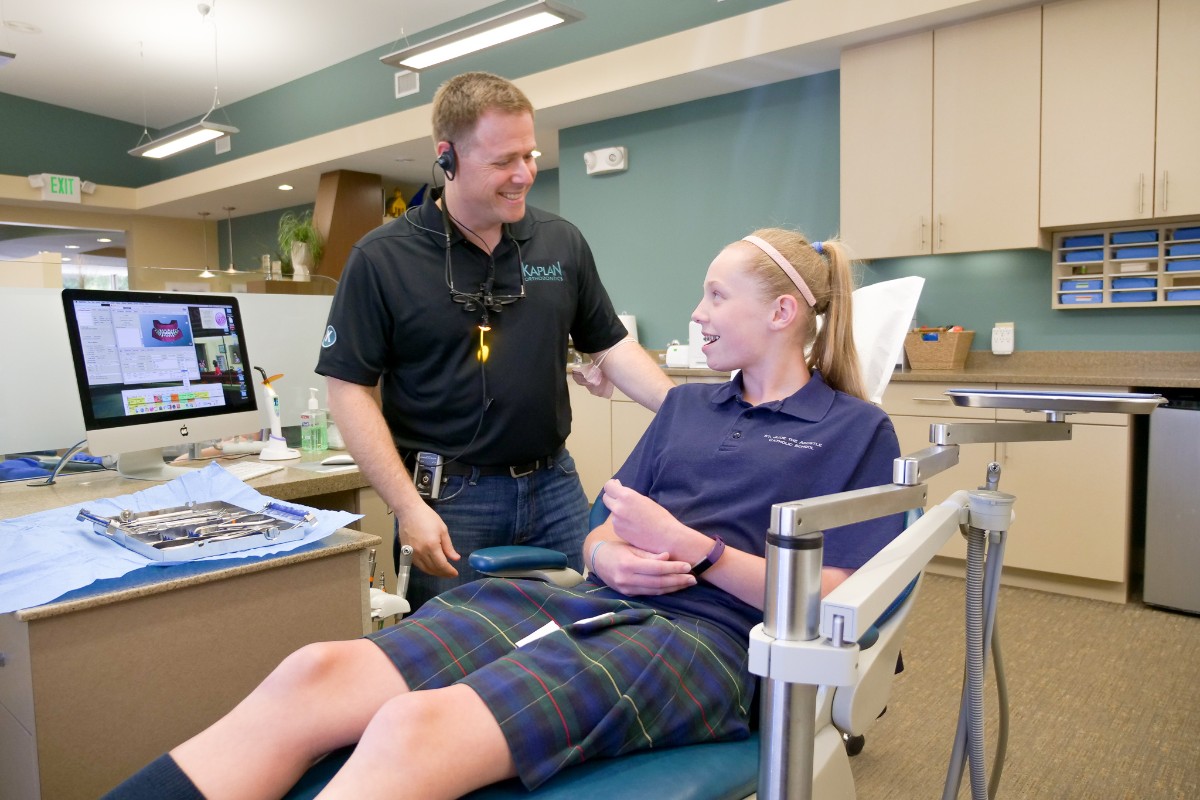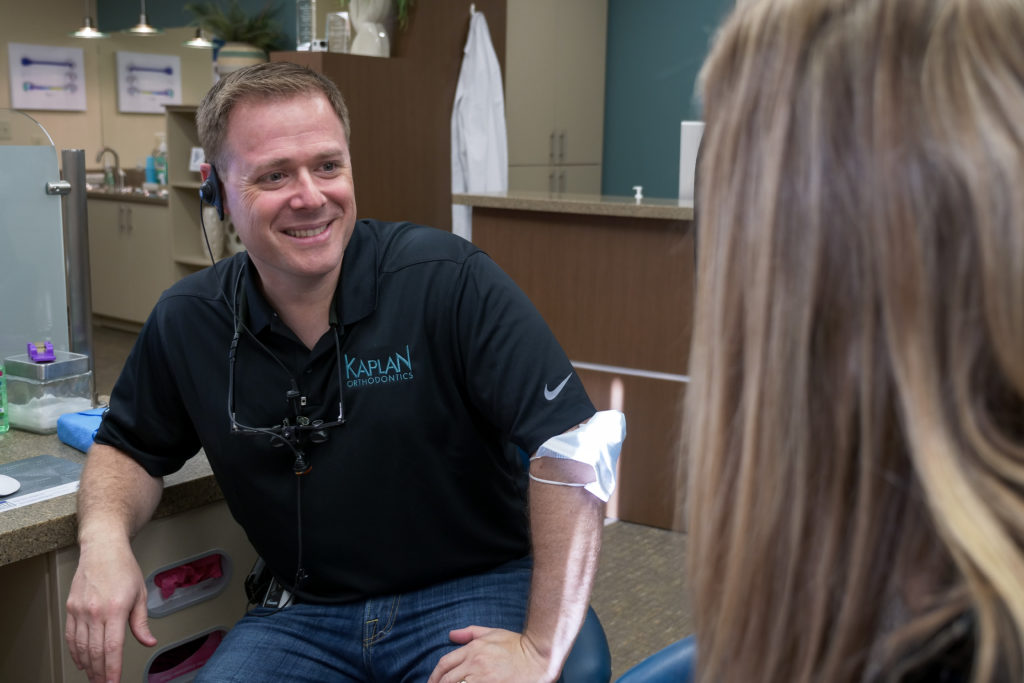
Two-Phase Treatment
The phrase “timing is everything” is relevant in many situations, particularly when you have children. That includes trying to work out if, when, and what kind of orthodontic treatment your child will need. There’s a lot of information available about this subject, both online and off, and it can easily become overwhelming. However, this doesn’t have to be a stressful experience for you or your child! Kaplan Orthodontics is here to help you understand what any long-term plan for your child’s orthodontic care is likely to include.
When it comes to ensuring your child has a healthy, functional smile, the first step should be an orthodontic evaluation with an experienced orthodontist like Dr. Kaplan. We support the recommendation issued by The American Association of Orthodontists that all children should have their first orthodontic consultation by the age of seven. This gives us the chance to find and diagnose many common dental issues before they have a chance to become more serious and problematic. Early intervention such as this can reduce the need for more intensive orthodontic treatment at a later age, and it can be summed up by the process of two-phase treatment.
Designed to be proactive rather than reactive, two-phase treatment is a specialized service we offer for younger patients we anticipate will need orthodontics as they grow. Keep reading to learn more about this treatment process, and how it can benefit your child’s oral health.
What is two-phase orthodontic treatment?
As the name implies, two-phase treatment is a process whereby a child receives orthodontic treatment at two separate times, with a break in between. The first phase of treatment will generally begin when the child still has a mix of primary and permanent teeth. There is then a period of rest before the second phase starts, usually, once the child has most or all of their adult teeth. Sometimes we will use braces or other orthodontic appliances during the first phase, but this will always depend on the specifics of each individual case. It’s much more common for braces or aligners to be used in the second phase of treatment.
Two-phase is often recommended with the goal of creating a better environment for a child’s permanent teeth to grow in. Two-phase orthodontic treatment can be used to:
- create a more optimal relationship between the teeth and jaws
- align the teeth, resulting in a straighter smile
- position the teeth and jaws for more pleasing facial symmetry
- give your child the best start for a healthy, attractive, and fully functional smile
Once Dr. Kaplan has had the opportunity to perform a thorough oral examination of your child’s teeth and jaws, the first phase of treatment may be recommended if:
- we feel that he or she will be prone to a particular problem that we want to keep from developing (preventive treatment)
- he or she already has a developing problem that we now want to intercept (interceptive treatment)
- we believe your child’s jaw bones may need a little bit of guidance as they grow (growth modification)
By following the patterns of normal childhood growth and development, we have the best chance to improve and correct any orthodontic issues early on. We, therefore, time the first phase of orthodontic treatment in order to take advantage of these predictable stages of dental development. Many common dental problems can be treated relatively easily in a growing child, but as they get older and their jawbones stop growing, these same issues may begin to require more invasive treatment. Early treatment is able to achieve lasting results for many of these issues, and can lessen the impact of others. That being said, most patients will still require a second phase of treatment in order to complete the alignment the first phase has begun.

How does two-phase treatment work?
Knowing the ins and outs of each phase, as well as what goes on during the resting period in between them, will help you understand how they work together to provide your child with a straight and healthy smile.
Phase One
Phase one treatment will generally be initiated in order to help a child’s jaw develop in a way that will accommodate all the permanent teeth. It can also improve the way the upper and lower jaws fit together. This method of treatment benefits patients in many ways, including an improved ability to bite, chew, and even digest food more effectively. It may also reduce the risk of damaged teeth due to issues such as crowding, misalignment, or malformed jaws.
Treatment in this phase will contribute to longer-term stability, meaning the teeth will stay in whatever position our orthodontists move them to. The second phase of treatment will continue this stabilization by moving the teeth into their final, better positions. But before this second phase is initiated, there will be a period of time where the permanent teeth are emerging. As this occurs, we suspend any orthodontic treatment, and let the teeth, jaws, and mouth have a temporary break.
Resting Period
Once we have successfully initiated and completed the first phase of treatment, there should be enough room for the remaining permanent teeth to have a clear path to erupt. Any teeth that have been moved will be stabilized with either a space maintainer or a fixed (non-removable) type of retainer during the resting period.
Phase Two
This second phase of treatment is where everything starts to come together. We will normally initiate this phase once all of your child’s permanent teeth have erupted. Successful treatment in phase two will often require braces or clear aligner therapy to be used for a time. Once a child’s orthodontic treatment is complete, fixed bonded retainers will generally be necessary to ensure that their newly straightened smile stays that way.
If two-phase treatment has been recommended for your child, and you decide to go ahead with it, there are some simple things you can do to help him or her achieve optimal results. This includes encouraging your child to:
- follow all of our instructions for the maintenance and care of their teeth and any orthodontic appliances being used
- maintain an excellent dental hygiene routine that includes brushing after every meal and before bed, and flossing at least once a day
- keep all scheduled appointments with Dr. Kaplan so we’re able to accurately monitor their progress
- visit their regular dentist every six months for a checkup and cleaning
- avoid any foods that can damage their appliance or teeth, including anything too crunchy or sticky
- maintain a healthy, varied diet

Looking beyond a “one size fits all” solution with Kaplan Orthodontics
Orthodontics should never be cookie-cutter. All smiles are not created equal, and what works for one child may not work for another. Here at Kaplan Orthodontics, we are committed to designing customized treatment plans based on each patient’s unique needs and goals. Our team is friendly and experienced, and we’ve worked hard to create an environment that is fun, relaxing, and comfortable for our patients. We’re proud to provide only the highest quality orthodontic care to families in Dunwoody and the surrounding communities!
If you have a child who is ready for their first orthodontic evaluation, or want to learn more about how two-phase orthodontic treatment could improve their oral health, get in touch with us today to schedule a free consultation with Dr. Kaplan. There’s never been a better time to start working towards a healthy, bright, beautiful smile for your child!

